
Needlefish or long toms are piscivorous fishes primarily associated with very shallow marine habitats or the surface of the open sea. Some genera include species found in marine, brackish, and freshwater environments, while a few genera are confined to freshwater rivers and streams, including Belonion, Potamorrhaphis, and Xenentodon. Needlefish closely resemble North American freshwater gars in being elongated and having long, narrow jaws filled with sharp teeth, and some species of needlefishes are referred to as gars or garfish despite being only distantly related to the true gars. In fact, the name "garfish" was originally used for the needlefish Belone belone in Europe and only later applied to the North American fishes by European settlers during the 18th century.
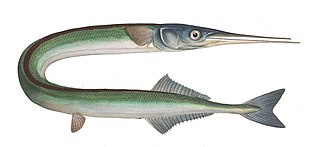
The garfish, also known as the garpike or sea needle, is a pelagic, oceanodromous needlefish found in brackish and marine waters of the Atlantic Ocean and the Mediterranean, Caribbean, Black, and Baltic Seas.
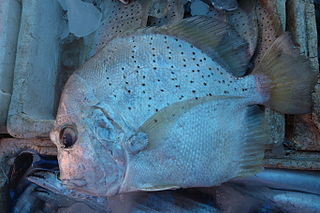
Drepane is a genus of marine and brackish water ray-finned fishes, known commonly as the sicklefishes. It is the only genus in the monotypic percomorph family Drepaneidae. These fish occur in the Indian and western Pacific Oceans, and in the eastern Atlantic near Africa.

Heniochus is a genus of marine ray-finned fish, butterflyfishes from the family Chaetodontidae. They are native to the Indo-Pacific. Though very similar in appearance to the Moorish idol (Zanclus cornutus), the members of this genus are not closely related to it.

The Dussumier's halfbeak, also known as the slender garfish, lives in reefs and shallow lagoons. It is an Indo-Pacific species which is found from the Seychelles east to the Tuamotu Islands, north to Hong Kong and Okinawa and south to northern Australia. They form schools which are found near the surface of lagoons and seaward reefs. The longest known specimen was 38.0 cm in length. This species was described by Achille Valenciennes in 1847 with the type locality given as the Seychelles. The specific name honours the French voyager and merchant Jean-Jacques Dussumier (1792-1883).
Allen's river garfish is a species of viviparous halfbeak endemic to West Papua in Indonesia.
Robert's river garfish is a species of viviparous halfbeak endemic to Papua New Guinea where it is only known from the area around Kokoda. This species grows to a length of 13 centimetres (5.1 in) SL.
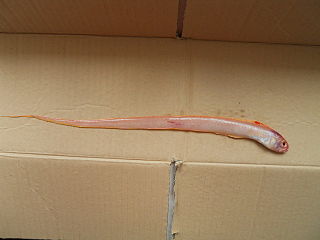
Cepola is a genus of marine ray-finned fishes belonging to the bandfish family, Cepolidae. The name red bandfish is applied to all members of this genus, but particularly C. macrophthalma, and generally not C. australis, which is also known as the Australian bandfish.
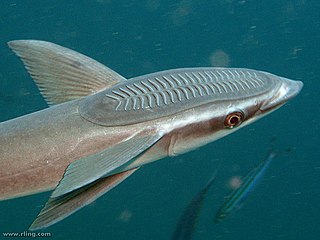
Echeneis is a genus of fish in the family Echeneidae, the remoras. The genus is distributed in the Atlantic, Pacific and Indian Oceans.
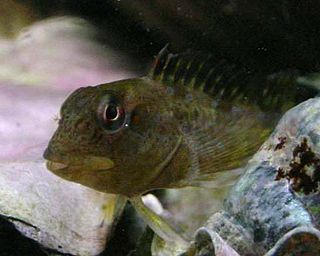
Lipophrys is a small genus of combtooth blennies found in Atlantic ocean and the Mediterranean Sea. It is one of 57 genera in the family Blenniidae. The generic name is made up of the Greek words lipo meaning "want" or "absence" and phrys meaning "eyebrow" referring to the lack of any cirri over the eyes in the type species L. pholis.

Allenbatrachus is a genus of toadfishes found in the Indian and western Pacific Oceans. The generic name honours the Humboldt State University ichthyologist George Allen (1923-2011), who introduced David Greenfield, who coined the name, to ichthyology.

Tylosurus is a genus of needlefish, one of ten in the family Belonidae. They are found worldwide in tropical and warmer temperate seas and two species have been recorded as Lessepsian migrants in the eastern Mediterranean Sea.
The short-beaked garfish is an uncommon species of needlefish in marine waters of the eastern Atlantic Ocean. This pelagic needlefish is present off the coasts of Ireland, Spain, Portugal, and the United Kingdom, and possibly in the Mediterranean Sea, as well. This species was thought to be the same as the garfish because they share the same waters. The short-beaked garfish matures at 30 cm (12 in) and can grow to a maximum of 65 cm (26 in) while Belone belone can be 95 cm (38 in). Like all needlefish, this one has an elongated body with beak-like jaws that are lined with razor sharp teeth. The short-beaked garfish's lower jaw is longer than the upper. Its body is silvery like most needlefish and has a black stripe running across its lateral line. The dorsal and anal fins are very close to the caudal peduncle. These fish are oviparous. Eggs may be found attached to objects in the water by tendrils on the egg's surface. These spherical eggs are dispersed on the sea floor (demersal). Not much is known about this fish's feeding habits. It likely preys on small oceangoing fish. It has been caught using mackerel. Needlefish tend to be surface fish, so are preyed upon like Atlantic mackerel, European pilchard, sand smelt, etc. The specific name honours Anatolii Nikolaevich Svetovidov (1903-1985) who was an ichthyologist at the Zoological Institute in Saint Petersburg, Russia and a colleague of N.V. Parin.

Diagramma is a genus of marine ray-finned fishes belonging to the family Haemulidae, grunts native to the Indian Ocean and the western Pacific Ocean. The currently recognized species in this genus are:

Tylosurus choram, the Red Sea houndfish, is a species of needlefish from the family Belonidae. A marine fish bluish in color with a long slender body, and a pointed long toothed beak, found in most temperate, warm seas, and sometimes rivers, it is found in abundance in the Red Sea. It is a fast predator swimming in small schools near the water surface. Like other species of needlefish this species is oviparous, laying eggs which attach themselves to objects in the water by means of filaments which cover the outer layer of the egg. Tylosurus choram is found in the Red Sea and in coastal waters around the Arabian Peninsula to the Gulf of Oman. It has been reported twice, forty years apart, in the Mediterranean Sea off Israel. This species was described as Belone choram by Eduard Rüppell in 1837 with the type locality given as the Red Sea, the specific name choram is Arabic for needlefish.

Sciaena is a genus of marine ray-finned fishes belonging to the family Sciaenidae, the drums and croakers. These fishes are found in the Eastern Pacific Ocean and the Eastern Atlantic Ocean.
The long tom or freshwater longtom is a species of euryhaline needlefish native to Northern Australia and Papua New Guinea.: This species occurs in the coastal rivers of tropical Australia and New Guinea. In Australia it has been recorded from the Fitzroy River in Western Australia to the Dawson River in Queensland. It is found in areas of still or flowing water in larger rivers from the tidal reaches to far inland and adults are infrequently recorded in coastal marine waters. Preferred habitats include river channels, floodplain lagoons, muddy creeks and billabongs where it often shelters below overhanging vegetation or among submerged roots. It is a nocturnal hunter of small fishes, crustaceans and insects with the adults being almost exclusively piscivorous, ambushing their prey from cover. Strongylura krefftii was described as Belone krefftii by Albert Günther in 1866 with the type locality given as "Australia ". The specific name honours the Australian zoologist Gerard Krefft (1830-1881) who presented Günther with the type.
Platybelone lovii is a species of needlefish from the family Belonidae. It is a predatory, pelagic fish which is endemic to the eastern Atlantic Ocean in the waters around Cape Verde. This species was described by Albert Günther in 1866 as Belone lovii and was named in honour of the British naturalist Richard Thomas Lowe (1802-1874).
Arrhamphus krefftii, the snub-nosed garfish, is a species of halfbeak in the genus Arrhamphus found in coastal waters of Australia from south of Rockhampton in Queensland to Sydney. The identity of the person honoured in the specific name is uncertain but it is thought that it may be the Australian zoologist and paleontologist Gerard Krefft (1830–1881). This species was previously classified as a subspecies of Arrhamphus sclerolepis, and remains so according to some authorities. This species is a herbivore and eats seagrass during the day. At night, it is a carnivore, eating mainly crustaceans.

Cepolinae is one of two subfamilies of marine ray-finned fish belonging to family Cepolidae, the bandfishes.













